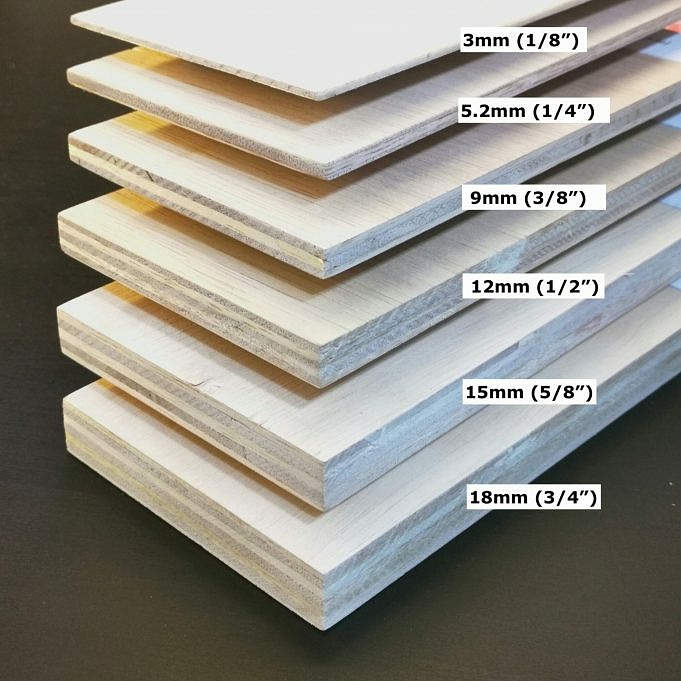Standard Plywood Sizes Width And Thickness
Share it
Plywood sheets are a common material used to make furniture and cabinets. But did you know that they can be made from different wood species with different sizes? You might not be familiar with the material and end up using the wrong type.
To avoid making this mistake, here’s a quick overview of standard plywood sizes as discussed by our wood experts.
Standard Plywood Sheet Sizes
Plywood sheets are made with layers of wood that have been glued together. This means that they can vary in material size. A standard plywood sheet is usually sold at 4×2.4m or 5×1.5m.
There are also different thicknesses available. These range from thin sheets measuring in at inch thick to thicker non-standard thickness standards measuring in at inch. Manufacturing companies also offer special sizes for this material. We will discuss these options below.
Plywood Dimensions: Width & Length
All plywood sold in the US is measured in standard English units. You’ll also notice that solid wood materials in other countries, such as Japan, Canada, Europe, and Canada, are measured using the metric system.
These wood sheets come in standard sizes of 4×2.4m. This is 1219mm by 2438mm when converted to metric measurements. Utility-grade plywood can be ordered in sizes up to 1.5m, and lengths up to 6 to 3 m.
Plywood Thickness: Actual Or Nominal
The right thickness of plywood is crucial for any project. This specification can range from 1 to 1 inches, but it doesn’t account for the wood’s actual thickness.
The term nominal thickness does not include the sanding that your material must go through. To get smooth plywood, you will need to take 1/81 cm off it.
When plywood is sanded during manufacturing, the actual size of the plywood is usually determined. Here are the thicknesses of pre-cut plywood sheets.
- inch = 7/163 cm
- inch = 7/81 cm
- 3/18 cm = 1/81 cm
- inch = 15/81 cm
- inch = 19/81 cm
- inch = 23/81 cm
Plywood Size Tolerances
Plywood materials consist of thin, wooden sheets that are glued together and aligned perpendicularly with the wood grain. These sheets have an external layer that indicates the plywood’s grade and the projects it can be used for.
Because its exterior layer is free from defects, sanded plywood can be considered top-grade plywood for furniture and cabinets making.
These premium materials have smaller size tolerances than those that are utility-grade. Cabinet plywood has a thickness tolerance of 1/163 cm. Utility-grade sheets have a tolerance of 1/81 cm.
Types Of Plywood: Hardwood Vs. Softwood
Because softwood plywood and hardwood plywood are made from different materials, they come in different sizes and thicknesses. You can choose from three sizes of hardwood plywood sheets: 2 x0.6 m, 2×1.2 m and 4×1.2 m.
You could use maple plywood, birch plywood or another tree to make the hardwood sheet you are looking for.
The softwood variety can be found in a range of sizes, including 4 x 2 m and 1 mm thickness. It is made from softwood trees such as pine, cedar, and others. It is a sheet that has a rough surface and can be used to build a roof, wall, or subfloor.
Plywood Core Types
Medium-density woodboard (MDF), is a type of heavy wood that is not suitable for home construction. This plywood core can be found in craft projects and speaker cases.
This core is the most popular, with wood-layered veneers that are glued in one plane and angle to create a strong structure. These materials are typically available with 5 to 7 veneers. However, you can get them with 13-ply if you need them for more heavy-duty projects.
These core materials are the most economical, but they are not water-resistant or prone to being damaged. These materials can be relied upon if you need to make workpieces that are not very durable or strong.
What Are Hardwood Plywood Veneers And How Do They Work?
Hardwood veneers can be visually pleasing so it’s not surprising they are used for decorative purposes. Our woodworkers say that its design and structure are not suitable for covering a roof, but they can be used to build furniture and cabinets.
These are the wood species that are most compatible for hardwood veneers.
- Mahogany Trees
- Walnut Trees
- Oak Trees
- Baltic Birch Trees
- Ash Trees
How To Choose The Right Plywood For Your Project
The plywood size you need depends on what kind of project you are working on. These wood materials come in different sizes and thicknesses. They also come from different wood species, which have different characteristics and durability.
FAQ
What sizes are the plywood sheets standard?
Standard plywood sheets are available in 48- and 51.5-m versions.
Which plywood is best for roofing?
For roofing purposes, external plywood is the best choice. These materials are more affordable but also easier to install and can withstand severe weather conditions.
Which plywood is the most affordable?
Grade D plywood is the most affordable option.
Conclusion
It doesn’t matter what kind of wood you use, knowing how it is measured and categorized can save you money and time.
Although it may sound simple, our team can assure you that this is not the case. We know that grades and sizes can be complicated if you don’t fully understand their value and uses. This post has everything you need.



